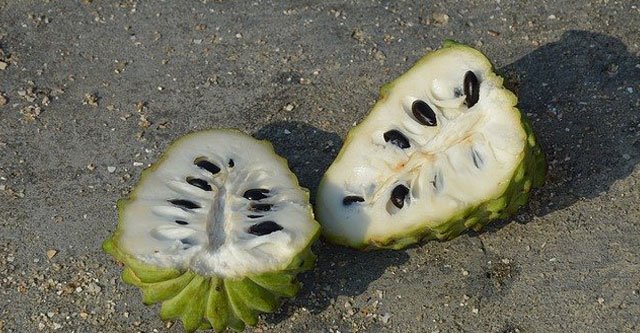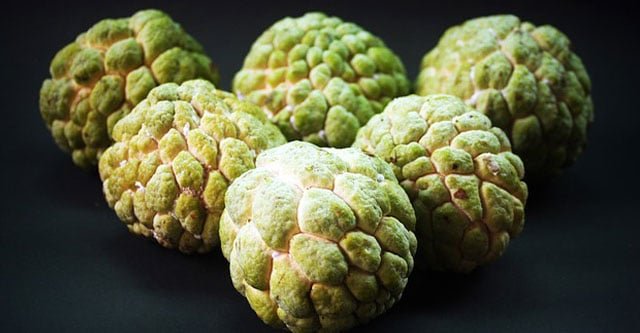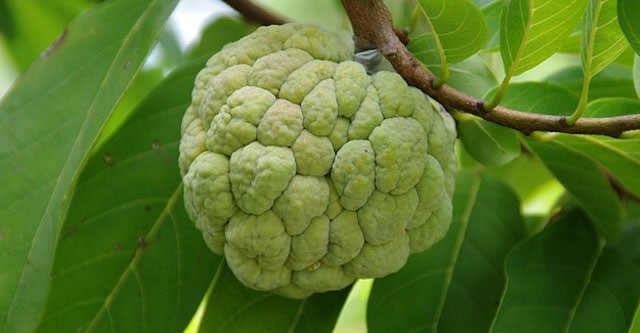Last Updated on January 26, 2023 by Dr Sharon Baisil MD
As a doctor, I understand the importance of managing diabetes while still enjoying life. Custard apples, with their sweet, creamy flavor and easy availability, may seem like an ideal snack for diabetics. But is custard apple safe for diabetics? In this blog post, I’ll be discussing the 6 potential dangers of custard apples for those with diabetes, helping you to make an informed decision about whether this tasty fruit is the right choice for you.
Can a diabetic patient eat Custard Apple (Sitaphal)?
Custard apple, also known as Sitaphal, has a low glycemic index of 54, which means that it does not cause a rapid increase in blood sugar levels. However, it has a moderate glycemic load of 10, which means that consuming a large quantity of custard apples may still cause a significant increase in blood sugar levels.
According to a study published in the Journal of Diabetes and Metabolic Disorders, the glycemic load of food may be more important for individuals with diabetes to consider than the glycemic index alone. The study found that a high glycemic load diet was associated with an increased risk of type 2 diabetes and that individuals with diabetes may benefit from limiting their intake of foods with a high glycemic load.
What is the Glycemic Index (GI) of Custard Apple (Sitaphal)?
The Glycemic Index of custard apple is 54, according to the research study published in Nature by Brand-Miller et al. which is in the low GI category
The Glycemic index is evidence of the speed of blood glucose elevation after a carbohydrate meal compared to the same amount of glucose or white bread.
Range of GI:
- 0-55(Low)
- 56-69(Moderate)
- 70 or above(High)
Glycemic Load (GL) refers to the carbohydrate amount of food. The glycemic index is multiplied by the carb content and then divided by 100.
Range of GL:
- 0-10(low)
- 10.1-19.9(Moderate)
- 20 or over(High)
The glycemic load of the Custard Apple is 10.2 bringing it to the moderate Glycemic Load category.
6 Dangers to Consider when Consuming higher amounts of Custard Apple if you have Diabetes

#1 Interaction with Medications
Custard apples contain an active compound called annonacin, which has been found to interact with certain diabetes medications, such as sulfonylureas and insulin. This can lead to hypoglycemia (low blood sugar) which can be dangerous and can lead to long-term complications associated with diabetes.
#2 Risk of Diabetic Nephropathy
A study published in the Journal of Food Science and Technology found that excessive custard apple consumption may increase the risk of diabetic nephropathy, a condition that affects the kidneys in people with diabetes. This is due to the fact that custard apples are high in potassium, which can be dangerous for those with diabetic nephropathy as it can affect kidney function.
#3 Hyperglycemia
Custard apples are naturally high in sugar, with one medium-sized fruit containing approximately 17 grams of sugar, which brings it to the moderate glycemic load category. For individuals with diabetes, consuming high amounts of custard apples can lead to blood sugar spikes, which can be dangerous and can contribute to long-term complications associated with diabetes.
#4 Increased Risk of Weight Gain
Consuming higher amounts of custard apples if you have diabetes can also increase your risk of weight gain. This is because custard apple is high in sugar and calories. A 100-gram serving contains approximately 120 calories, which can add up quickly if you are consuming higher amounts of this fruit. Over time, this can lead to weight gain and an increased risk of obesity-related complications such as heart disease and type 2 diabetes.
#5 Interference with Insulin Sensitivity
Finally, consuming higher amounts of custard apples if you have diabetes can also interfere with your insulin sensitivity. Insulin sensitivity is the body’s ability to respond to and process the hormone insulin. If your insulin sensitivity is impaired, this can lead to a variety of complications such as an increased risk of type 2 diabetes and heart disease.
What is the Nutritional Value of the Custard Apple (Sitaphal)?

Serving: 100 gm
Total calorie: 94 kcal
| Nutrients | Nutritional Value | Percent(%) daily value( based on a 2000calorie diet) |
| Total carbohydrates | 24 g | 8% |
| Dietary fibers | 4.4 g | 17% |
| Protein | 2.1 g | 4% |
| Total fat | 0.3 g | 0% |
| Cholesterol | 0 mg | 0% |
| Sodium | 9 mg | <1% |
| Potassium | 247 mg | 7% |
| Magnesium | 18 mg | 5% |
| Calcium | 30 mg | 2% |
| Iron | 0.71 mg | 3% |
| Vitamin A | 33 IU | 0% |
| Vitamin B6 | 0.221 mg | 10% |
| Vitamin C | 19.2 mg | 60% |
| Riboflavin | 0.100 mg | 8% |
There are more traces of other nutrients but in minimal amounts.
How much custard apple can you eat a day, if you have Diabetes?
Since it has a moderate glycemic index, only one medium-sized custard apple measuring about 100 mg, is enough for a day for diabetic individuals.
What is the latest research on the benefits of custard apples in Diabetes?

★ A review of 8 different studies refers to a 27% lower risk of cataract and macular degeneration in individuals with high blood levels of lutein than those with low levels.
★ There is a review of the effect of potassium on lowering blood pressure.
If anyone takes the recommended dietary intake(RDI) level of potassium ( 4700 mg), it will decrease both the systolic and diastolic pressure by 8 and 4 mm of Hg(approx.), respectively.
★ A review of 10 studies says that regular magnesium intake can reduce high blood pressure risk by up to 8%.
★ A test-tube study showed some catechins’ capability to stop the growth of breast cancer cells up to 100%.
★ Another study regarding the low growth and replication of bladder cancer cells due to the treatment with epicatechin.
★ An animal study found that mice fed with epicatechin reduce inflammatory marker C- reactive protein(CRP).
★A human study observed the positive effects of vitamin C in reducing the duration of the common cold.
All the antioxidants and other nutrients that bring about changes are found in custard apples in plenty.
Some studies have shown the toxic and poisonous effects of the seeds and skin.
Annonacin, a toxic compound found in the skin and seeds, is responsible for some serious adverse effects on the brain and nervous system. Parkinsonism may occur from this.
So you must carefully peel off the skin and remove the seeds before eating custard apples. Persons with parkinsonism should avoid eating sitaphal.
Besides this, custard apples can increase weight. So people with diabetes should eat this after a logical calculation of calories.
Frequently Asked Questions
Summary
- Custard apple, also known as Sitaphal, has a low glycemic index of 54, which means that it does not cause a rapid increase in blood sugar levels.
- However, it has a moderate glycemic load of 10, which means that consuming a large quantity of custard apples may still cause a significant increase in blood sugar levels.
- Custard apples contain an active compound called annonacin, which has been found to interact with certain diabetes medications, such as sulfonylureas and insulin. This can lead to hypoglycemia (low blood sugar) which can be dangerous and can lead to long-term complications associated with diabetes.
- A study published in the Journal of Food Science and Technology found that excessive custard apple consumption may increase the risk of diabetic nephropathy, a condition that affects the kidneys in people with diabetes.
- Custard apples are naturally high in sugar, with one medium-sized fruit containing approximately 17 grams of sugar, which brings it to the moderate glycemic load category. For individuals with diabetes, consuming high amounts of custard apples can lead to blood sugar spikes, which can be dangerous and can contribute to long-term complications associated with diabetes.
- Consuming higher amounts of custard apples if you have diabetes can also interfere with your insulin sensitivity.
- Since it has a moderate glycemic index, only one medium-sized custard apple measuring about 100 mg, is enough for a day for diabetic individuals.
References
https://www.ncbi.nlm.nih.gov/pmc/articles/PMC6672878/
https://www.ncbi.nlm.nih.gov/pmc/articles/PMC7884895/
https://www.ncbi.nlm.nih.gov/pmc/articles/PMC8143160/
https://pubmed.ncbi.nlm.nih.gov/18607145/
https://pubmed.ncbi.nlm.nih.gov/26433307/
https://www.nature.com/articles/s41598-020-65769-5
https://www.cdc.gov/diabetes/basics/prediabetes.html
https://fdc.nal.usda.gov/fdc-app.html#/food-details/173953/nutrients






Dr. Sahib,
My wife is diabetic for past 18 years. Can she take green tea with Custard Apple leaves (2-3 leaves)? Can this be taken for longer period? If yes, for how long?
Regards,
Satgur P GAUR
9717744019
Hi Satpur,
Custard apple leaves are used in Ayurveda for reducing sugar levels. However, you should monitor the functioning of her kidney, before trying it. It can be done by doing the Blood Urea and Serum creatinine levels.
A better alternative is using guava leaves tea, which is scientifically proven for treating high sugar levels.
However, always use these herbal remedies as a complementary treatment to the existing medications, and never use them as a replacement.
In case you need more help with diabetes, I have an exclusive group where I share daily diabetes tips. You can become a member for just $1(Rs 73)/month
Here is the link: https://www.buymeacoffee.com/beatdiabetes